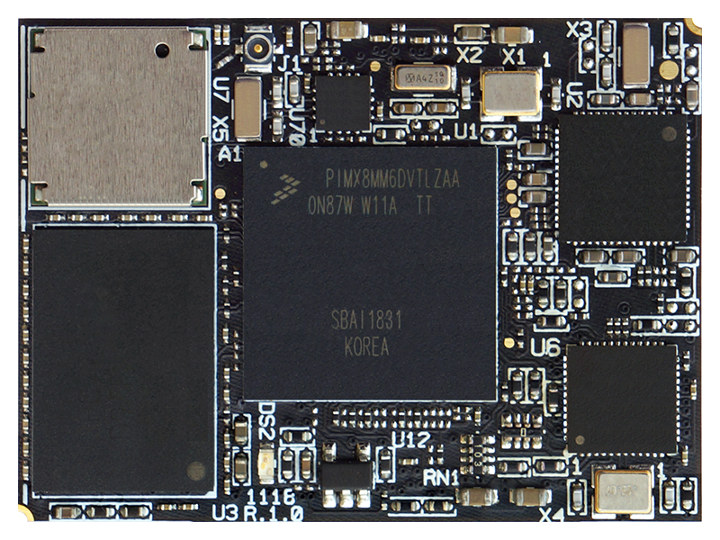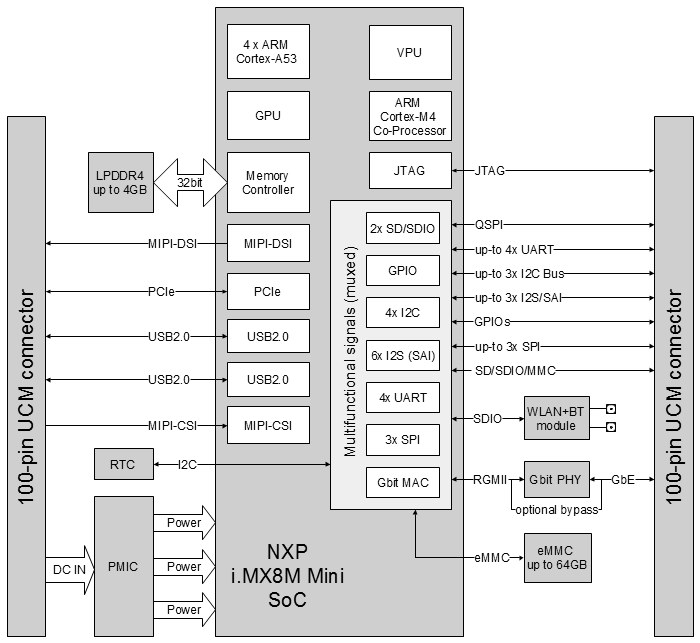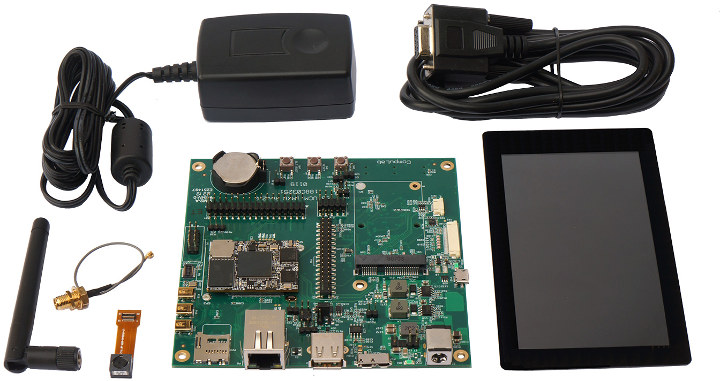We’ve recently written about several new hardware platforms based on the latest NXP i.MX 8M Mini processor family including Nitrogen8M_Mini SBC and F&S Elektronik PicoCore MX8MM SoM. Thanks to a new 14-nm process, the new family has the advantage of consuming less power, and the Cortex-A53 cores can run at a higher frequency. They should cost less as well thanks to cost-saving measures like the adoption of a 1080p video decoder instead of a 4K decoder found in the older NXP i.MX 8M family.
CompuLab has now launched their own NXP i.MX 8M Mini SoM with UCM-iMX8M-Mini module that’s about the size of a largish stamp (38 x 28 mm) suitable for portable and space constrained applications such as professional handheld devices, wearable healthcare monitors and medical devices, autonomous drones with visual object recognition, or portable instrumentation equipment with advanced HMI.
 CompuLab UCM-iMX8M-Mini SoM specifications:
CompuLab UCM-iMX8M-Mini SoM specifications:
- SoC (one or the other)
- NXP i.MX8M Mini Quad Arm Cortex-A53 processor @ 1.8GHz, Arm Cortex-M4F real-time core, GC NanoUltra 3D GPU, GC320 2D GPU, 1080p60 H.265, H.264, VP9 and VP8 decode, and 1080p60 H.264 and VP8 encode.
- NXP i.MX8M Mini Dual Arm Cortex-A53 processor @ 1.8GHz, Arm Cortex-M4F real-time core, GC NanoUltra 3D GPU, GC320 2D GPU, 1080p60 H.265, H.264, VP9 and VP8 decode, and 1080p60 H.264 and VP8 encode.
- NXP i.MX8M Mini DualLite Arm Cortex-A53 processor @ 1.8GHz, , Arm Cortex-M4F real-time core, GC NanoUltra 3D GPU, GC320 2D GPU, no video processing unit.
- System Memory – Up to 4GB LPDDR4 RAM
- Storage – Up to 64GB of on-board eMMC flash
- Networking
- On-board Gigabit Ethernet PHY
- Wireless module with Dual-band WiFi 802.11ac, Bluetooth 4.2 BLE
- 2x 100-pin board to board connectors (0.4mm pitch) exposing
- 1x MMC/SD/SDIO interface
- Display
- 4- lane MIPI-DSI up to 1920 x 1080 @ 60Hz
- Touchscreen capacitive touch-screen support through SPI and I2C interfaces
- Camera I/F – 4-lane MIPI-CSI interface
- Audio – Up to 3x I2S / SAI
- USB – 2x USB2.0 dual-role ports
- PCI – PCIe x1 Gen. 2.1
- UART – Up to 4x UART ports
- General I/O – Up to 3x I2C, 3x SPI, 4x PWM, 85x GPIO
- Supply Voltage – 3.45V to 4.4V
- Dimensions – 38 x 28 x 4 mm
- Weight – 7 grams
- Temperature Range – -40 to 85°C

The company provides Linux and Android BSP’s and firmware images with Linux kernel 4.14, Yocto Project file-system (for Linux), and U-Boot bootloader.
To quickly get started with evaluation and early software development, SB-UCMIMX8 carrier board and EVAL-UCM-iMX8M evaluation kit are provided.
SB-UCMIMX8 carrier-board key features:
- Board-to-board sockets for UCM-iMX8M-Mini SoM
- Storage – Micro SD card socket
- Display and Camera
- LCD panel – MIPI-DSI interface, up to 1920×1080, FPC connector; capacitive touch-screen interface, FPC connector; gully supports Startec KD050HDFIA020 5″ 1280×720 LCD panel
- Camera – MIPI CSI, 2×12 B2B connector; compatible with LI-OV5640-MIPI-AF camera module
- Network
- 1000/100/10Mbps Ethernet port, RJ45 connector
- 802.11a/b/g/n/ac WiFi 5 + Bluetooth 4.2 BLE (Broadcom BCM43353 chipset)
- Cellular – Support for cellular modem via mini-PCie socket, on-board micro-SIM card socket
- Audio
- Analog Audio – Analog stereo output, line-in, 3.5mm jacks implemented with the CL-SOM-iMX8 audio codec
- Digital Audio – S/PDIF input/output, 3.5mm jacks
- USB – 1x USB2.0 host, type-A connector, 1x USB2.0 OTG, micro-USB connector
- Serial
- 1x serial debug port via UART-to-USB bridge, micro-USB connector
- 1x serial debug port via RS232 transceiver, ultra-mini serial connector (mutually exclusive with serial debug port via USB)
- Up-to 2x UART, 3.3V levels, 100-mil header
- Expansion
- mini-PCIe socket, full-size
- 100-mil I/O headers with up to 1x SPI interface, up-to 2x I2C interfaces, up-to 34x GPIO’s, JTAG
- Misc – RTC + coin-cell battery
- Supply Voltage – Unregulated 8V to 18V
- Digital I/O voltage – 3.3V
- Dimensions – 118 x 118 x 22 mm
- Weight – 125 grams

EVAL-UCM-iMX8M evaluation kit includes one UCM-iMX8M-Mini SoM, one SB-UCMIMX8 carrier board, a 5” WXGA LCD panel, a 5MP camera module, a power supply, cables and a technical support contract.
UCM-iMX8M-Mini is available now starting at $54 for volume orders (1k +) in minimum configuration, while EVAL-UCM-iMX8M evaluation kit is offered for $385. More information about the SoM, devkit and detailed options prices can be found in the product page.

Jean-Luc started CNX Software in 2010 as a part-time endeavor, before quitting his job as a software engineering manager, and starting to write daily news, and reviews full time later in 2011.
Support CNX Software! Donate via cryptocurrencies, become a Patron on Patreon, or purchase goods on Amazon or Aliexpress





I wonder what applications these things actually turn up in. $54 sounds pretty expensive for something you’re going to mass produce.
Are you serious? $54 sounds like a steal.
>Are you serious? $54 sounds like a steal.
Yes. I was literally asking hence writing a question and hitting the “post comment” button.
What sort of product do you use a single part that costs $54 in? CNC machinery? If $54 is a steal
what would you integrate this into? Keep in mind you need to buy $54000 worth of parts to get
that price.
There’s a lot more in the world than cheap consumer applications.
For professional use, a well documented and supported product with a long time availability will save a lot of money compared to a cheap, flaky product with no support.
>For professional use, a well documented and supported product with a long time
>availability will save a lot of money compared to a cheap, flaky product with no support.
If you’re selling something for $200 your BoM needs to be under $50 really. So what “professional” stuff does something like this get used in? I wasn’t doubting that these things do get used in something. I’m more interested in what sort of product makes it cost efficient to use. My first guess would have been extremely low volume stuff but it looks like it’s a minimum 1K order.
A minimum of 1K is nothing for most markets. If you don’t plan to sell 1K of a $200-priced product (your pricepoint, not mine), you’re a joker.
As per your question — that thing is a perfect candidate for signage and billboards.
>A minimum of 1K is nothing for most markets.
1K is nothing for low cost high volume stuff. Something based around a single component that costs $54 wouldn’t be in that category I wouldn’t have thought hence asking.
>If you don’t plan to sell 1K of a $200-priced product
>(your pricepoint, not mine), you’re a joker.
Have a guess why I picked that price point. There’s a good reason.
It’s weird how you’d be a joker for shipping in low volumes but not a joker for using something that is directly marketed at the low volume market. You would use a SoM like this because you are making limited run products and it’s not cost effective to spin your own board, do your own EMC testing etc. Once you’re selling tens of thousands of units just the board to board connectors to mount this thing will be adding tens of thousands of dollars to your production costs.
>As per your question — that thing is a perfect candidate for signage
That sounds about right. Batches of a few thousand would probably be in the sweet spot for this.
>and billboards.
So these probably make sense for products sold in the thousands that cost a few thousand dollars per unit.
@ £599 a phone, maybe these?
”
While Purism was considering a switch to the i.MXM8 Mini, NXP pushed out a software update for the i.MX8M Quad which resolved the issues, so that’s the chip that will be used for the Librem 5.
With that in mind, here’s the final run-down of the specs for this smartphone:
5.5 inch to 5.7 inch HD display
NXP i.MX8M Quad processor
32GB of eMMC storage + microSD card reader
Gemalto PLS8 3G/4GB modem (on a replaceable M.2 card)
TESEO LIF3 multiconstellation GNSS/GPS receiver
9-axis motion sensor
Front and rear cameras (specs TBD)
Vibration motor
USB-C port
User-replaceable battery
At least one speaker
PureOS GNU/Linux-based operating system ”
It’s obvious you’re wrong, since there are quite a few companies (not just CompuLab) that have been making a living for decades selling SOMs that cost >$50. There’s a world outside of your imagination; a couple markets I know a bit about include medical and industrial.
I’ll give you an example of industrial thinking: I spec gold connectors on our machines, because if using gold instead of tin saves one service call, the gold connectors have been worth it (either in avoiding warranty costs or avoiding costs to our reputation). Long term availability also matters; we have machines that are >15 years old and still going strong.
Even at high volumes, a company might not care to design their own SOM; designing reliable PCBs with high speed interfaces is non-trivial.
Typical response in the CNX-software comments on any SOC/MCU that is priced more than an ESP8266 or AllWinner SOC : “oh my God! $54 so expensive!! I can get similar AllWinner SOC for $2-5”.
Ok fine go use your cheap and poorly documented AllWinner SOC and leave us alone. Some of us will gladly buy the $54 for the god damn module.
> “oh my God! $54 so expensive!! I can get similar AllWinner SOC for $2-5”.
That’s not what I wrote at all. $54 is a lot of money for a single component in a BoM. Considering the audience of this site I thought someone might actually be able to point out where these sort of things are cost effective. There again maybe I should have expected a bunch of people that don’t know but wanted to chime in with their big boy thoughts regardless.
>poorly documented AllWinner SOC and leave us alone.
Who is “us”? Anyhow it’s weird you bring up the AllWinner stuff as linux sunxi is probably one of the most active ARM SoC trees. Isn’t even hardware video decoding in/going in to mainline?
>Some of us will gladly buy the $54 for the god damn module.
So you’re going to buy $54,000 worth of components. Ok.. what are you going to use them in? What makes this module more cost effective in your design? It doesn’t seem to be have FCC module certification or anything..
FYI: According to their pricing table the basic module (1GB of RAM, 4GB of emmc, no wifi etc) is $54 * 2.5 (single unit pricing). That’s $135. Add wifi and 2GB of RAM and you’re looking at ~$200 a pop. Maybe $200 a pop is ok for some super special industrial machine but if you want the industrial temp tested version that’s another $150 on top.
So I’ll be interested to know what you’re using your 1000s of modules in or what you’re building that would make these worth using considering the cost.
WTF? 54$ Way too much. The combination sounds interesting though. Combining a M core and A core. You could wakeup the A core when some event happens.
usb 2.0 only…